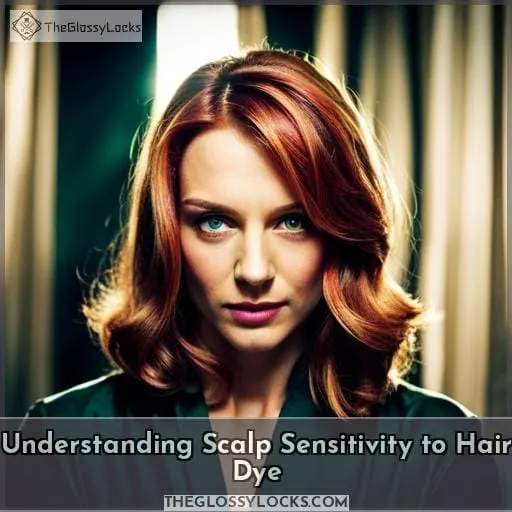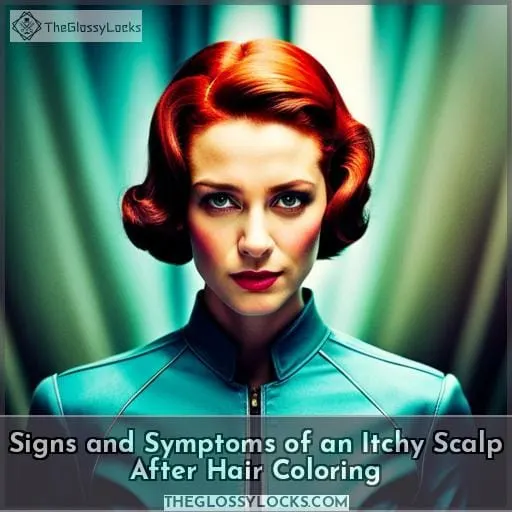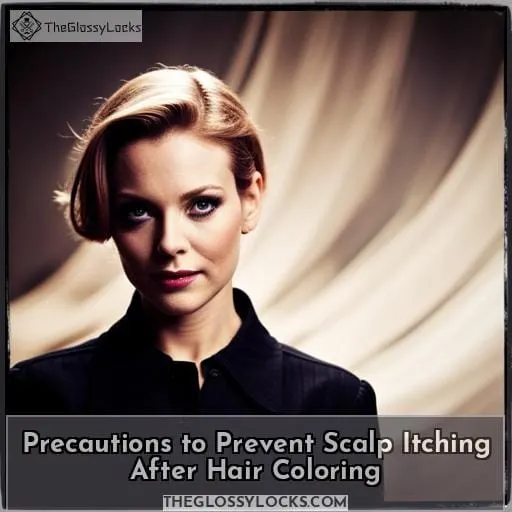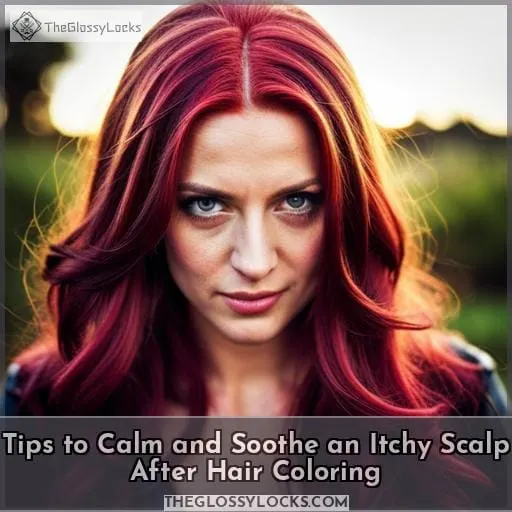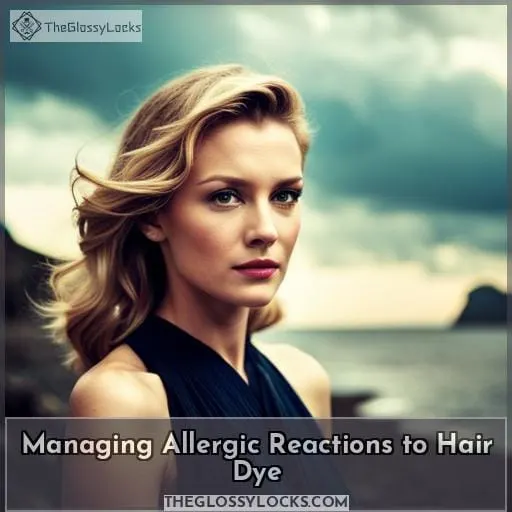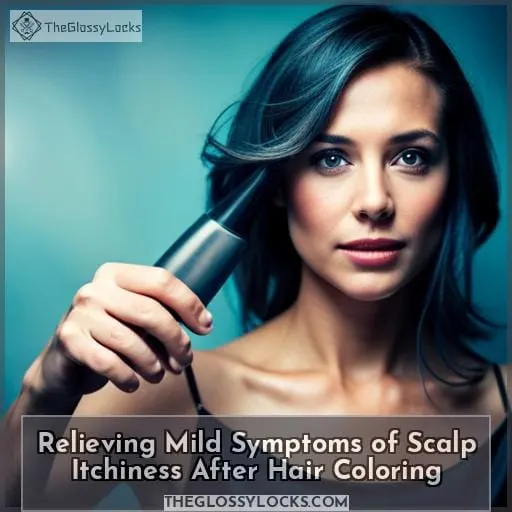This site is supported by our readers. We may earn a commission, at no cost to you, if you purchase through links.
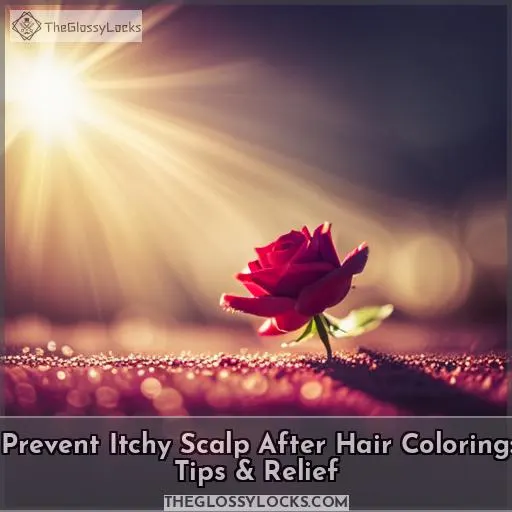 Curious about scalp itching after hair coloring? You’re not alone. It can be a frustrating and uncomfortable experience, but the good news is that it’s preventable — and treatable if you do get an itch.
Curious about scalp itching after hair coloring? You’re not alone. It can be a frustrating and uncomfortable experience, but the good news is that it’s preventable — and treatable if you do get an itch.
Hair dyes contain chemicals that may cause allergic reactions or irritation in certain people, making them more likely to react than others. To avoid this issue altogether, here are some tips for preventing itchy scalp after dyeing your hair — as well as relief options for those who have already experienced discomfort from a reaction.
Table Of Contents
- Key Takeaways
- Understanding Scalp Sensitivity to Hair Dye
- Signs and Symptoms of an Itchy Scalp After Hair Coloring
- Precautions to Prevent Scalp Itching After Hair Coloring
- Tips to Calm and Soothe an Itchy Scalp After Hair Coloring
- Managing Allergic Reactions to Hair Dye
- Relieving Mild Symptoms of Scalp Itchiness After Hair Coloring
- Preventing Future Reactions and Avoiding Products With PPD
- Conclusion
Key Takeaways
- Patch testing before dyeing hair helps identify potential allergens. Washing your hair 24-48 hours before dyeing, as part of pre-dye hair washing tips, helps identify potential allergens.
- Avoid washing hair before coloring to prevent scalp irritation.
- Non-permanent and PPD-free alternatives to hair dye are safer options.
- Highlights, extensions, and glossing treatments are scalp-friendly alternatives.
Understanding Scalp Sensitivity to Hair Dye
Understanding scalp sensitivity to hair dye is a crucial step in preventing itching after coloring. Chemicals like ammonia, PPD, and sulfates found in the dyes can cause allergic contact dermatitis, while pH changes and skin irritation are also known culprits.
Chemicals in Hair Dye
Knowing the chemicals in hair dye and how they can cause allergic reactions or skin irritation is key to protecting your scalp from uncomfortable itching. PPD, PTD, ammonia, and sulfates are common ingredients that can produce redness and swelling.
pH balance should be checked as well for itchy scalps caused by alkaline imbalance. Natural alternatives don’t necessarily mean safe; patch test to identify allergens before using permanent or semi-permanent dyes and use Sweet’N Low to reduce possible irritation.
With knowledge of potential risks and proper care techniques, you can prevent your scalp from itching after hair coloring.
Allergic Contact Dermatitis
Be aware that allergic contact dermatitis is a common cause of an itchy scalp after hair dye. Patch testing, allergy clinic visits, and understanding hair dye sensitivity can help prevent scalp itching.
Natural dyes also pose risks due to their pH levels and irritation potential. To avoid reactions, learn about ingredients in the product prior to purchase or application.
PH Changes and Skin Irritation
When you color your hair, the pH level of the dye can cause skin irritation and result in an itchy scalp. Pre-coloring measures like patch testing and using a pH-balanced shampoo are recommended to reduce discomfort.
Post-coloring measures such as moisturizing treatments, antihistamines for itch relief, and washing with a mild shampoo should be taken if experiencing scalp irritation from hair dyeing. Taking care of your scalp’s health by being mindful of pH balance will help prevent allergic reactions when coloring your hair.
Signs and Symptoms of an Itchy Scalp After Hair Coloring
If you have recently dyed your hair and are noticing swelling, redness, and inflammation on your scalp, along with a type-4 delayed allergic reaction or increased sensitivities due to aging, then you may be dealing with an itchy scalp after hair coloring.
It’s important to take the necessary steps to prevent itching from occurring as well as identify any allergies that may be present.
Swollen, Red, and Inflamed Scalp
If you’ve experienced a swollen, red, and inflamed scalp after coloring your hair, it may be an allergic reaction. Hair dye ingredients can cause skin irritation and weaken the skin barrier, leading to itching.
To reduce inflammation, use hydrogen peroxide or emollients to soothe your scalp. Allergy testing is recommended to identify allergens before using permanent or semi-permanent dyes.
Type-4 Delayed Allergic Reaction
You may be experiencing a Type-4 delayed allergic reaction, which manifests itself with symptoms such as itching and rash developing several days after exposure to an allergen.
Delayed reactions can occur when the scalp is particularly sensitive or if certain allergens are present in hair dye. Patch testing beforehand can help identify any triggers; PPD allergy being one of the most common ones for darker shades.
Long-term care should include using hypoallergenic products and following safety instructions when coloring your hair, such as wearing gloves and rinsing thoroughly afterwards to avoid further irritation or sensitivities.
Increased Sensitivities With Aging
As you age, your skin’s sensitivities can increase and cause more irritation from hair dye chemicals. Scalp care is essential to prevent an itchy scalp reaction; natural or organic dyes are less likely to cause allergies, but they may still contain irritants.
Allergic contact dermatitis is a common risk with coloring, so patch test before permanent or semi-permanent applications. To reduce the risk of itching and other reactions, use non-PPD alternatives like highlights; moisturize after washing; take antihistamines for itch relief; wash frequently with a mild shampoo.
Precautions to Prevent Scalp Itching After Hair Coloring
Before coloring your hair, it is important to take precautions in order to prevent scalp itching. A patch test should always be done prior to applying permanent or semi-permanent dye, as this can help identify any potential allergens that may result in irritating skin reactions afterward.
Perform a Patch Test
To identify potential allergens and find out what your skin can tolerate, performing a patch test is key. Patch testing before any hair coloring is essential to avoid allergic reactions like inflammation, itching, or swelling.
It’s also important to know the ingredients of your dye. Ammonia-free dyes are safer than those with chemical components like PPD or sulfates. Natural alternatives should be evaluated too. Some labels are unregulated and can cause irritation as well.
Allergy clinics offer helpful tests for more sensitive individuals who need extra caution when selecting their hair color products.
Avoid Washing Hair Before Coloring
Before you color your hair, refrain from washing it! This can lead to scalp irritation and an uncomfortable itch. Do a patch test first if using new dye—it’s like an allergy test for peanuts. To ensure safe dyeing, use preventive measures such as ammonia-free color application and check scalp health.
Avoid allergies with coconut oil or chamomile tea rinses before coloring; steroid cream or antihistamine may help relieve mild symptoms afterward.
Non-Permanent and PPD-Free Alternatives
Exploring non-permanent and PPD-free alternatives to hair dyeing can help you maintain a healthy scalp. There are plenty of options for those looking to prevent allergic reactions. From temporary color sprays to scalp-friendly dyes, you have choices.
Hair extensions, highlights, and calming an itchy scalp with natural products are also viable options. Additionally, glossing treatments allow you to keep your look without irritation. It is important to note that permanent or semi-permanent dark shades should only be used after a patch test has been done first.
Highlights and Extensions as Alternatives
Discover the dazzling effects of highlights and extensions to give your hair a beautiful, unique look without risking an itchy scalp. Consider coloring without harsh chemicals or PPDs by opting for stylish extensions or subtle highlights.
Treat mild irritation with home remedies such as aloe vera gel before considering chemical alternatives.
Tips to Calm and Soothe an Itchy Scalp After Hair Coloring
Are you suffering from an itchy scalp after coloring your hair? Well, don’t worry; thorough washing of the hair with a mild shampoo is one of the best tips to soothe and calm an itchy scalp. This will help in preventing further irritation and inflammation due to chemicals present in most hair colors.
Thoroughly Wash Hair With Mild Shampoo
To soothe an itchy scalp after hair coloring, thoroughly wash your hair with a mild shampoo to reduce irritation and inflammation. However, beware of other ingredients in the shampoo that can cause allergic reactions unless they are organic or natural.
Choose a shampoo specifically for post-coloring care and perform a patch test before using it. Additionally, there are alternatives to dye, such as highlights or extensions, available.
Use Hydrogen Peroxide or Emollients for Soothing
Relieve your scalp’s discomfort with a hydrogen peroxide treatment or an emollient moisturizer for soothing relief. Hydrogen peroxide: 1) kills bacteria, 2) reduces inflammation, 3) cleanses the scalp of dirt and debris, 4) helps to restore pH balance in skin cells, 5) diminishes the risk of PPD sensitivity.
Emollients are natural remedies that provide instant calmness; they can help lock in moisture while reducing allergic reactions. Both treatments will leave you feeling relieved and refreshed! Use these simple tips to achieve itch-free hair coloring results without compromising safety or comfort levels.
Consider Organic/Natural Dyes, but Be Cautious
Although organic/natural dyes may seem like a solution for an itchy scalp, be cautious. They can also cause allergic reactions, so it’s important to be aware of the ingredients and do research before using them.
Consider highlights or extensions as an alternative for natural-looking color without direct contact with the scalp.
If you’re considering permanent or semi-permanent dyeing, it’s recommended to do a patch test, even when using natural products. This will help reduce the risk of a reaction to any potential allergens in the product’s ingredients list.
For relief from itching, try washing your hair thoroughly with a mild shampoo and applying hydrogen peroxide or emollients that provide soothing comfort.
Sweet’N Low to Reduce Alkalinity and Irritation
Try adding Sweet’N Low to your hair color mix to reduce irritation and give your scalp some relief. Natural alternatives, patch testing, and allergy clinics are all options for minimizing anaphylaxis risk while coloring.
Hair dye can be harsh on the skin, so incorporating a natural sweetener like Sweet’N Low into the mix helps lower alkalinity levels and reduces itching post-dyeing.
Using Sweet’N Low in hair color mixes can help reduce itchiness after dying.
Natural alternatives, patch testing, and allergy clinics minimize anaphylaxis risk during coloring.
Incorporating a natural sweetener helps lower alkalinity levels and reduces itching post-dyeing.
Managing Allergic Reactions to Hair Dye
Are you preparing to dye your hair and worried about allergic reactions? Managing an allergy to hair dye can be tricky, but with the right precautions, it’s possible to keep your scalp from itching after coloring.
Identify Allergens Through Patch Testing
To protect your skin from potential irritants and allergens, consider patch testing before dyeing your hair. It’s a simple procedure that identifies possible allergic reactions to ingredients in the hair dye.
Patch tests are beneficial for those with sensitive skin or who have previously experienced an allergic reaction to some products. With this method, it’s easier to identify which allergen causes the most irritation so you can avoid them when selecting a product for coloring your hair.
Allergy clinic visits may also help individuals determine their sensitivities and prevent any adverse reactions caused by exposure to certain substances in dyes or other related products used during treatments such as highlights and extensions options too!
A patch test will provide valuable information on how different chemicals interact with an individual’s skin, empowering them with knowledge about what they should avoid when dying their locks.
Consult an Allergy Clinic for Testing and Guidance
If you’re worried about your sensitivity to hair dye, it’s important to consult an allergy clinic for testing and guidance—otherwise, you’re flying blind. Patch testing, skin sensitivity analysis, symptom identification, and itch relief solutions can all be found by consulting a specialist.
Allergy clinics specialize in identifying the source of allergies quickly and accurately so that individuals can find safe solutions for their scalp issues caused by hair dyes.
- Practical advice on how to reduce reactions
- Accurate diagnosis based on patch tests
- Comprehensive treatment plans tailored specifically for each individual’s needs
By taking these steps towards understanding potential allergies before using any kind of hair dye product, you will help ensure a safe coloring experience with minimal or no adverse reactions!
Recognize Signs of Mild, Allergic, and Severe Reactions
Be mindful of the signs your body is sending you after hair dyeing; mild reactions can quickly escalate to more serious, potentially dangerous allergic or anaphylactic responses. Recognize itching scalp solutions and sensitivity tips before a reaction occurs.
Understand what causes a hair dye allergy and how to identify severe reaction signs for better safety. Be aware that even natural labels could be unregulated with unknown ingredients, leading to unwanted effects on the skin’s barrier.
Relieving Mild Symptoms of Scalp Itchiness After Hair Coloring
If you’re looking for relief from mild scalp itchiness after hair coloring, washing your hair and applying a moisturizing treatment is a great first step. By taking these proactive measures, you can help soothe the irritation while also protecting your newly colored locks.
Wash Hair and Apply Moisturizing Treatment
After dyeing your hair, soothe mild symptoms of itchiness by giving it a gentle wash and applying a moisturizing treatment. Hydrate the scalp with beneficial ingredients to reduce irritation and provide relief from itching.
Regularly massage in products specifically designed for color-treated hair. This will replenish moisture levels, strengthen strands, and improve condition. Protect the delicate skin on your head while nourishing it, so you can enjoy vibrant colors without worrying about discomfort or dryness caused by harsh chemicals in dyes.
Take this time after coloring as an opportunity for self-care. Incorporate scalp care into your routine for long-lasting results!
Use Steroid Cream for Skin Irritation
To soothe skin irritation after hair dyeing, try applying a steroid cream. Benefits include fast relief of itching and redness, decreased inflammation, and long-term maintenance for severe cases. Natural alternatives like aloe vera or honey can be used with caution as they may cause further reactions.
Patch testing with an allergy clinic is recommended to identify allergens and reduce the risk of anaphylaxis.
Take Antihistamines for Itch Relief
Take an antihistamine to quickly soothe the intense itching and burning sensation that comes with a hair dye reaction. Allergy testing can help identify which dyes cause sensitivity, while natural alternatives provide non-permanent options.
The coloring technique also affects scalp irritation – highlights, extensions, or glossing avoid contact with the skin for shine without discomfort. When used correctly, antihistamines offer relief from mild symptoms of itchy scalps after coloring.
Preventing Future Reactions and Avoiding Products With PPD
It is important to understand the safety of PPD in hair dye and take necessary precautions for safe use. To prevent scalp itchiness from happening again, make sure you read and follow directions carefully when using products with PPD.
Understand the Safety of PPD in Hair Dye
It is important to understand the safety of PPD in hair dye, as higher levels can increase the risk for an allergic reaction. Patch testing and allergy clinic tests are recommended before permanent or semi-permanent coloring.
Black henna use should be avoided due to its high risk of anaphylaxis. In addition, directions on product packaging must be followed carefully and strictly adhered to for the best results with minimal side effects.
Practicing caution when dealing with chemicals could prevent irritation and other scalp issues that arise from using dyes containing PPD or similar ingredients.
Follow Directions and Precautions for Safe Use
When dyeing your hair, always make sure to follow the directions and take precautions to ensure safe use. Patch testing before using permanent or semi-permanent dyes can help identify potential allergies.
It is also important to avoid harsh chemicals like PPD to reduce the risk of irritation. If you prefer not to use strong dyes, there are natural alternatives available. However, it is still important to read labels carefully and patch test these products as they may still contain allergens that could trigger a reaction.
Additionally, washing your hair with a mild shampoo before coloring and maintaining the pH balance can help keep your skin healthy during the coloring process.
Following these steps will help you safely color your hair without experiencing any unwanted itching or other reactions!
Consider PPD-Free Alternatives and Organic Options
Considering PPD-free alternatives and organic options may be helpful in avoiding scalp irritation after hair coloring. One option that many people find works best with minimal reactions is natural henna.
Patch testing can help identify potential allergens. Preventive measures, such as avoiding washing before dyeing and taking extra care of the scalp, are also recommended for those who want to reduce their risk of itching or other reactions.
Non-permanent dyes, highlights, extensions, and glossing treatments offer additional ways to enjoy colorful styles without irritating the skin or risking an allergic reaction due to chemicals found in permanent dye products containing PPD.
Conclusion
It often comes as no surprise that approximately one in three people will experience an allergic reaction to hair dye. Despite the risks, hair coloring is still a popular choice for those looking to enhance their look.
To protect your scalp from itching after hair coloring, it’s important to take a few precautions. Prior to any treatment, perform a patch test to reduce the likelihood of an allergic reaction.
Additionally, wash your hair with a mild shampoo before coloring and use a moisturizing treatment after rinsing to keep your scalp hydrated and soothed.
Following these tips can help prevent an itchy scalp after hair coloring and reduce the risk of a reaction.

